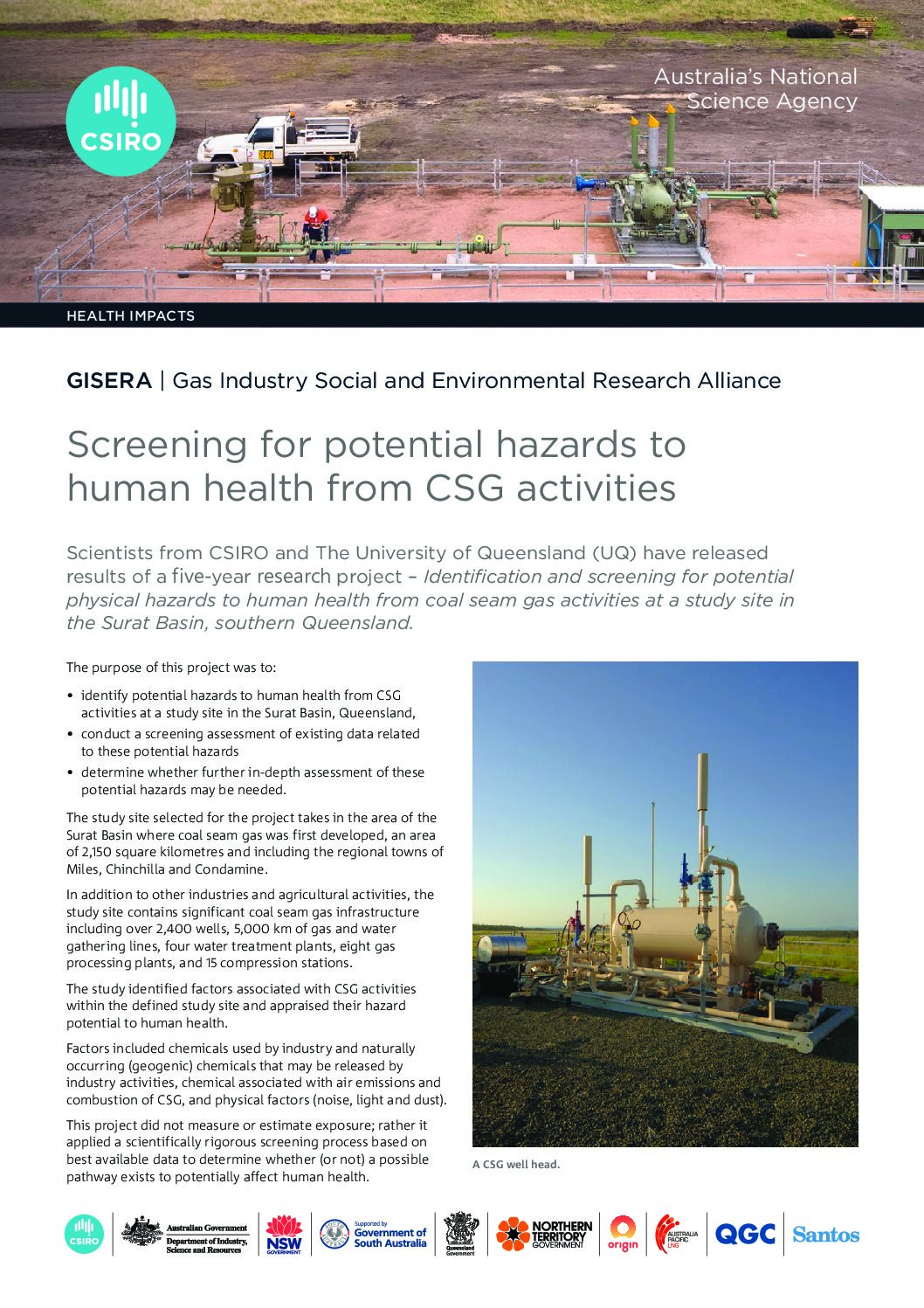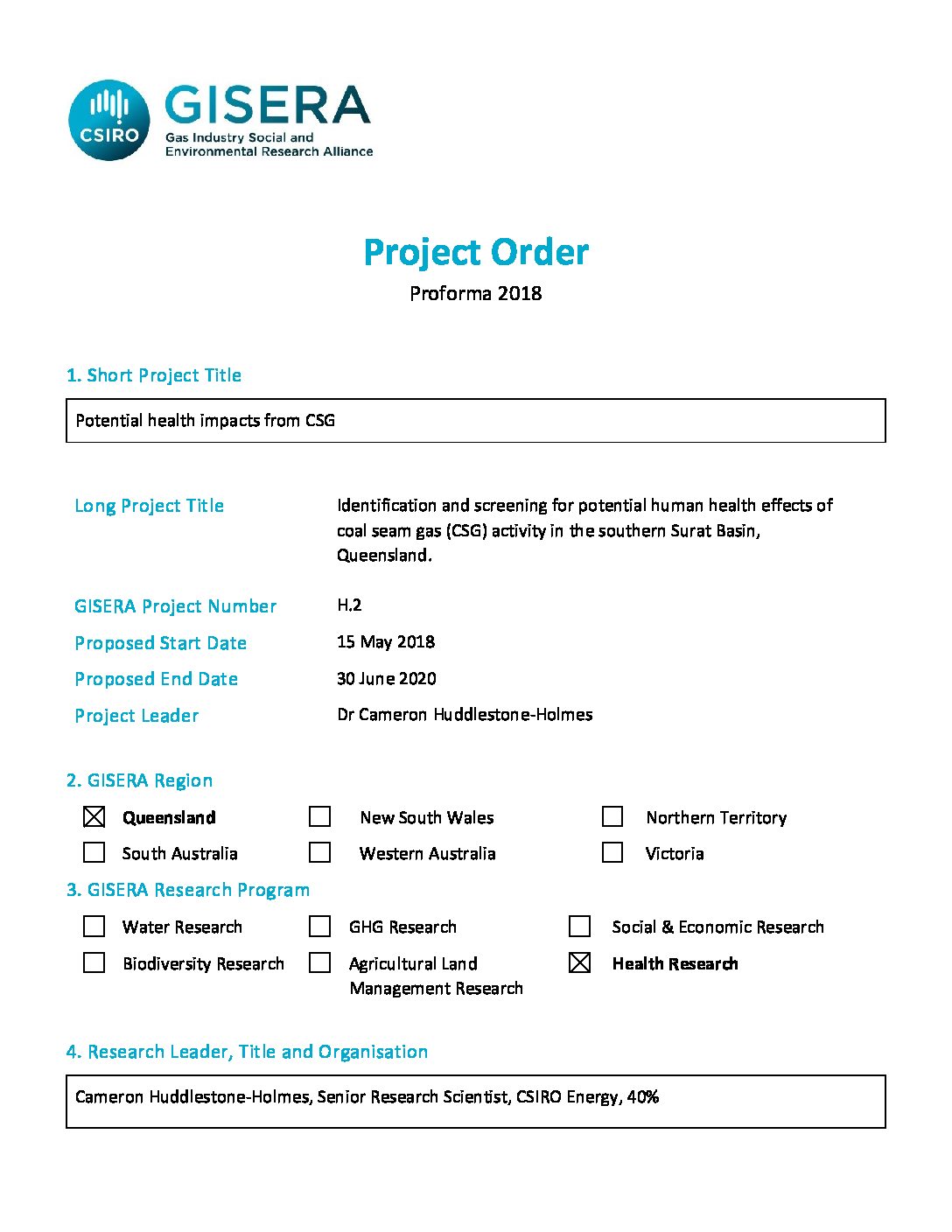Potential health impacts from CSG
New research has been released into the potential for coal seam gas (CSG) activity in Queensland to affect human health.
This project established processes and governance to ensure research quality, defined project boundaries, identified potential hazards and exposure pathways, and screened relevant data.
A 2,150 square kilometers study site in the Surat Basin, Queensland, was selected and factors that could lead to potential hazards such as chemicals, air emissions, noise, light and dust associated with CSG activities were identified and appraised. Existing data related to these factors was screened to determine whether any factors would require in-depth assessment.
Key results
The study found that for the majority of factors, there was no plausible pathway to impact human health. Noise and light emissions from CSG activities do not pose a hazard to physical health in the study site. Chemical factors associated with air emissions from CSG activities were within relevant health-based air quality objectives.
Of the 97 unique chemical factors used in CSG drilling and hydraulic fracturing operations:
- 72 were assessed and found to have low hazard potential to human health at the study site.
- 25 chemical factors (in eight groups) warrant further in-depth assessment. Based on the available evidence, none of these chemicals were found to represent an acute hazard to human health in the study site.
- A CSIRO extension study examined the microbial degradation of these groups of chemical factors in soil and aquifer samples and found that four chemical groups degraded readily in soils within days, and more slowly in aquifer samples.
Further research
In response to this study two new CSIRO research projects are underway and will conduct further in-depth studies focussing on these eight groups of chemical factors.
One of the newly approved studies – Exposure assessment of identified chemicals used in CSG activities – will examine the seven chemical groups that have a potential pathway to affect human health via soils and groundwater. The other study – Analysis of dust near CSG sites to assess potential for respirable crystalline silica – will focus on the eighth chemical factor, silica dust, which has a potential airborne pathway to affect human health. Both new studies will involve comprehensive field sampling campaigns.
Research update Investigating the potential health impacts of coal seam gas September 2018
[The CSIRO, Australia Pacific LNG, QGC, Origin, Santos, NSW Government and Australian Government Department of Industry, Innovation and Science logos and text appears: GISERA, Gas Industry Social and Environmental Research Alliance, www.gisera.csiro.au]
[Music plays and text appears on a green screen: Research update, Investigating the potential health impacts of coal seam gas activities, September 2018]
[Image changes to show the CSG site in amongst dry grassland and then the image changes to show Cameron Huddlestone-Holmes talking to the camera and text appears: Cameron Huddlestone-Holmes, Senior Research Scientist, CSIRO]
Cameron Huddlestone-Holmes: This project is the first comprehensive study of the potential health impacts of coal seam gas activities in Australia.
[Images move through of aerial views of the site, water flowing through in an area bounded by cement and then Sharon Grant talking to the camera and text appears: Sharon Grant, Queensland Alliance for Environmental Health Sciences, The University of Queensland]
Sharon Grant: So, what we’re trying to ascertain is whether there are any human health impact from chemical and physical hazards related to coal seam gas activities.
[Image changes to show Andrea Walton talking to the camera and then the image changes to show a group of people wearing high-vis standing at the back of a ute and talking and text appears: Andrea Walton, Social Scientist, CSIRO]
Andrea Walton: We’ve got three sort of committees that we’re going to have to sort of help that process.
[Camera zooms in on some of the people wearing high-vis clothing and then the image changes to show the group at the CSG site and the camera zooms in on them]
We’ve got one committee which is a local stakeholder reference group. We’re also having a technical reference group and then we’re going to have what we call an oversight committee.
[Image changes to show Andrea talking to the camera]
So, this is going to be a really important study for Australian unconventional gas.
[Images flash through of some of the equipment on the CSG site, Sharon talking to the camera, a view of the CSG gas site, a cow standing in front of the site, and Sharon talking to the camera again]
Sharon Grant: Once we’ve established that we will go into an identification phase where we try to look for complete exposure pathways, where a chemical or a physical hazard might be emitted from the activities as industry and actually move through the environment and impact a person.
[Image changes to show a female operating a touch screen in a monitoring station and then the image changes to show the female face as she looks up and then her hand operating the touch screen]
So, that might involve putting out some monitors, some monitoring devices, some samplers, to collect more information.
[Image changes to show Sharon talking to the camera again]
There may be modelling involved.
[Images move through of Andrea talking to the camera, the CSG gas site amongst grassland, a close-up view of a male working on the site, and cattle moving around the site and text appears: Andrea Walton, Social Scientist, CSIRO]
Andrea Walton: We want to produce a project that is not only scientifically robust and of very high quality, but we want it to be really trusted.
[Image changes to show a female looking at a computer screen inside a monitoring station and then the image changes to show Camera Huddlestone-Holmes talking and text appears: Cameron Huddlestone-Holmes, Senior Research Scientist, CSIRO]
Cameron Huddlestone-Holmes: The outcomes of this research will help to inform Government and industry about how they can carry out their activities to minimise any potential health impacts should there be any.
[Images move through of an aerial view looking down on the CSG site, workers wearing hi-vis in conversation, the CSG site, a fenced off body of water, tanks on the site, and Sharon talking again]
Sharon Grant: At every point in the project we can actually go back to the committees and say, “This is what we’ve found”, “This is what we’re proposing to do next” if we want to shine light on this process and bring our stakeholders along with us on this journey to understand some of the answers that people are looking for.
.
[Music plays and the CSIRO, Australia Pacific LNG, QGC, Origin, Santos, NSW Government and Australian Government Department of Industry, Innovation and Science logos and text appears: GISERA, Gas Industry Social and Environmental Research Alliance, www.gisera.csiro.au]
Potential health impacts from coal seam gas



